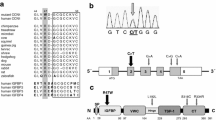Abstract
Background
Atrioventricular septal defects (AVSDs) occur as clinical defects of several different syndromes, as autosomal dominant defects, and as sporadically occurring malformations. Consequently, there is genetic heterogeneity, but until recently, little is known about the genes involving in the pathogenesis of AVSD. CRELD1 gene, a novel cell adhesion molecule, is a candidate gene for AVSD.
Methods
This study included 133 patients with AVSD and 200 healthy controls. Peripheral blood samples were collected and genomic DNA was extracted from the leukocytes. CRELD1 was amplified by polymerase chain reaction (PCR) with specific primers. The sequences of PCR products were compared between the patients and controls.
Results
In a patient, a C-to-G transition was identified at nucleotide 857 in exon 8 that resulted in a substitution of alanine for proline at amino acid 286 in the first calciumbinding EGF domain. This patient had an isolated partial AVSD and the mutation was inherited from her mother. Another mutation was detected in a patient with a partial AVSD and evidence of Down syndrome. The heterozygous c.973G>A transition in exon 9 resulted in a substitution of lysine for glutamic acid at amino acid 325 (E325K) in the second calcium-binding EGF domain.
Conclusions
Two novel CRELD1 mutations were identified in the calcium-binding EGF domain in patients with AVSD. CRELD1 is likely to be an AVSD-susceptibility gene and CRELD1 mutations may increase the risk of developing a heart defect rather than being a direct causative mutation.
Similar content being viewed by others
References
Ferencz C, Loffredo CA, Rubin JD, Magee CA. Perspectives in pediatric cardiology. NY: Futura Publishing Company press, 1997.
Sheffield VC, Pierpont ME, Nishimura D, Beek JS, Burns TL, Berg MA, et al. Identification of a complex congenital heart defect susceptibility locus by using DNA pooling and shared segment analysis. Hum Molec Genet 1997;6:117–121.
Green EK, Priestley MD, Waters J, Maliszewska C, Latif F, Maher ER. Detailed mapping of a congenital heart disease gene in chromosome 3p25. J Med Genet 2000;37:581–587.
Rupp PA, Fouad GT, Egelston CA, Reifsteck CA, Olson SB, Knosp WM, et al. Identification, genomic organization and mRNA expression of CRELD1, the founding member of a unique family of matricellular proteins. Gene 2002;293:47–57.
Clark EB. Mechanisms in the pathogenesis of congenital heart defects. In: Pierpont ME, Moller J, eds. The Genetics of Cardiovascular Disease. Boston: Martinus-Nijoff, 1986: 3–11.
Clark EB. Pathogenetic mechanism of congenital cardiovascular malformations revisited. Semin Perinatal 1996;20:465–472.
Marino B, Digilio MC, Toscano A, Giannotti A, Dallapiccola B. Congenital heart diseases in children with Noonan syndrome: an expanded cardiac spectrum with high prevalence of atrioventricular canal. J Pediatric 1999;135:703–706.
Ferencz C, Loffredo CA, Correa-Villasenor A, Wilson PD. Genetic and Environmental Risk Factor of Major Cardiovascular Malformations. The Baltimore-Washington Infant Study 1981–1989. New York: Futura Publishing press, 1997.
Marino B, Vairo U, Corno A, Nava S, Guccione P, Calabrò R, et al. Atrioventricular canal in Down syndrome. Prevalence of associated cardiac malformations compared with patients without Down syndrome. Am J Dis Child 1990;144:1120–1122.
Carmi R, Boughman JA, Ferencz C. Endocardial cushion defect: further studies of “isolated” versus “syndromic” occurrence. Am J Med Genet 1992;43:569–575.
Digilio MC, Marino B, Toscano A, Giannotti A, Dallapiccola B. Atrioventricular canal defect without Down syndrome: a heterogeneous malformation. Am J Med Genet 1999;85:140–146.
Marino B. Left-sided cardiac obstruction in patients with Down syndrome. J Pediatr 1989;115:834–835.
Francalanci P, Marino B, Boldrini R, Abella R, Iorio F, Bosman C. Morphology of the atrioventricular valve in asplenia syndrome: a peculiar type of atrioventricular canal defect. Cardiovasc Pathol 1996;5:145–151.
Digilio MC, Marino B, Ammirati A, Borzaga U, Giannotti A, Dallapiccola B. Cardiac malformations in patients with oralfacial-skeletal syndromes: clinical similarities with heterotaxia. Am J Med Genet 1999;84:350–356.
Cousineau AJ, Lauer RM, Pierpont ME, Burns TL, Ardinger RH, Patil SR, et al. Linkage analysis of autosomal dominant atrioventricular canal defects: exclusion of chromosome 21. Hum Genet 1994;93:103–108.
Wilson L, Curtis A, Korenberg JR, Allan L, Chenevix-Trench G, Stephenson A, et al. A large, dominant pedigree of atrioventricular septal defect (AVSD)-exclusion from the Down syndrome critical region on chromosome 21. Am J Hum Genet 1993;53:1262–1268.
Robinson SW, Morris CD, Goldmuntz E, Reller MD, Jones MA, Steiner RD, et al. Missense mutations in CRELD1 are associated with cardiac atrioventricular septal defects. Am J Hum Genet 2003;72:1047–1052.
Zatyka M, Priestley M, Ladusans EJ, Fryer AE, Mason J, Latif F, et al. Analysis of CRELD1 as a candidate 3p25 atrioventicular septal defect locus (AVSD2). Clin Genet 2005;67:526–528.
Sarkozy A, Esposito G, Conti E, Digilio MC, Marino B, Calabrò R, et al. CRELD1 and GATA4 gene analysis in patients with nonsyndromic atrioventricular canal defects. Am J Med Genet A 2005;139:236–238.
Posch MG, Perrot A, Schmitt K, Mittelhaus S, Esenwein EM, Stiller B, et al. Mutations in GATA4, NKX2.5, CRELD1, and BMP4 are infrequently found in patients with congenital cardiac septal defects. Am J Med Genet 2008;146A:251–253.
Pierpont ME, Markwald RR, Lin AE. Genetic aspects of atrioventricular septal defects. Am J Med Genet 2000;97:289–296.
Ferencz C, Boughman JA, Neill CA, Brenner JI, Perry LW. Congenital cardiovascular malformations: questions on inheritance. Baltimore-Washington Infant Study Group. J Am Coll Cardiol 1989;14:756–763.
Maslen CL, Babcock D, Robinson SW, Bean LJ, Dooley KJ, Willour VL, et al. CRELD1 mutations contribute to the occurrence of cardiac atrioventricular septal defects in Down syndrome. Am J Med Genet A 2006;140:2501–2505.
Author information
Authors and Affiliations
Corresponding author
Rights and permissions
About this article
Cite this article
Guo, Y., Shen, J., Yuan, L. et al. Novel CRELD1 gene mutations in patients with atrioventricular septal defect. World J Pediatr 6, 348–352 (2010). https://doi.org/10.1007/s12519-010-0235-7
Received:
Accepted:
Published:
Issue Date:
DOI: https://doi.org/10.1007/s12519-010-0235-7




